Unwanted: A Teenage Memoir of Japanese Internment
I am a member of a once despised minority group, American Japanese, who spent three-and-a-half years incarcerated in an American concentration camp during World War II. Although that ordeal ended 72 years ago, the impact of that experience on my life and its broader implications for American society resonate deeply to this day.
At the beginning of the war, roughly 10 percent of the adult “alien” men on the West Coast (Japan-born persons being ineligible for citizenship) were picked up by the FBI as potentially dangerous and interned by the Justice Department, effectively robbing the community of leadership. We had been under surveillance for quite a while, and these men were singled out. My father, who was an alien, was not picked up, though many of our friends were. None ever were convicted of a crime or act of sabotage, though many were held for years in captivity.
I was a U.S. citizen by birth, but the distinction meant nothing at the time. My entire family — my parents, two sisters, and I — was sent to Poston in southwestern Arizona, geographically the largest of the 10 War Relocation Authority (WRA) camps where American Japanese were held. At the time, I had just turned 12. By the time we were permitted to leave, I was 15.
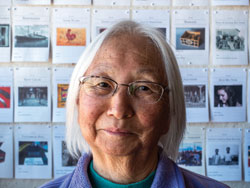
Photo by Dave Izu
We, along with approximately 120,000 others, spent the better part of four years in desolate areas where we were monitored, our movements restricted. We ate in mess halls, and our tar-paper barracks were so flimsy I remember wind and dust storms so strong that rooftops were torn off, debris flying around like crumpled paper.
Perhaps even more of a shock to me than the prison-like conditions was the fact that for the first time in my life, I was living totally surrounded by others of Japanese descent. In my early school years, most of my classmates were white, with a scattering of Mexican-American kids. Although I was one of the few American Japanese in my small town, I never experienced any prejudice there. But at Poston, my farm upbringing contrasted sharply with the sophistication, manners, and clothes of the American-Japanese kids from Los Angeles and other cities.
Here we were, all locked up together, doing our best to be “normal” teens. My mother disapproved of the camp’s faster growing-up process, driven by the city kids. She wasn’t sure about my going to the parties and dances that were a big part of teen life at the camp, and she did not want me to have a brassiere or wear makeup. I missed my white classmates, my home, my town, and my less-pressured life. I felt like an ugly duckling.
We had the trappings of society like schools, jobs, a camp government, a police and fire department. My father did some woodcarving while my mother took sewing lessons, making our dresses. I spent a lot of time reading books from the library. But life was far from normal. The usual social hierarchy was turned upside down, with the elders stripped of power and the young freer to pursue their interests.
It was the pettiness of life in camp that got to me. Almost every aspect of everyone’s life was known to all, and this promoted a culture of gossip and rumor mongering, with whispers and speculations about others filling our time. The meanness, the nastiness exhibited, the way we picked on one another, was an ugliness I hadn’t known before. Of course, it was a manifestation of the cramped living conditions, the forced idleness, and the insecurity of our situation.
A group formerly known for hard work and pride in our accomplishments was reduced to committing little acts of rebellion aimed generally at the government and administration who were oppressing us. People “stole” wood scraps to make furniture and pilfered food from the mess halls. Many did not feel that manual work was worth doing and slacked off, held strikes, and quit their “jobs.” My father “borrowed” a tractor and took a mob of kids to the Colorado River, a couple of miles from the camp.
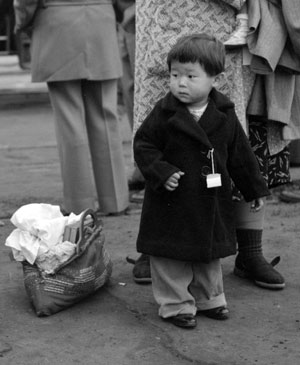
Photo from The National Archives and records Administration
I was too young and naive to understand the bigger picture, but the smaller world I inhabited was beset with contradictions. In eighth grade, a white schoolteacher from Massachusetts ordered us to memorize a Marc Antony speech from Shakespeare’s Julius Caesar. “Friends, Romans, countrymen, lend me your ears,” it began. “I come to bury Caesar, not to praise him. The evil that men do lives after them; The good is oft interred with their bones.” We labored mightily to master those lines and dozens more. But, alas, most of us had trouble doing it, and she castigated us as ignorant, lazy know-nothings.
There were those, particularly older men, who listened to Japanese propaganda broadcasts on smuggled-in radios. Reports of Japanese victories would elicit some cheers. Clumps of men would discuss the latest “news,” sneering at those who didn’t believe, severely criticizing those who remained loyal to the U.S.
Our community was caught up in this international war at a particularly sensitive period. My parents’ generation was still culturally old country. Some, like my mother, never learned to speak English. Their children, including me, were rapidly becoming Americanized. I joined the Girl Scouts and edited the junior high newspaper, The Desert Daze.
In prewar times, it was customary to send children to Japanese school because many believed that eventually they were going to return to their home country. In some places, it was a Saturday-only class, but in my case, we attended an hour of Japanese lessons each day, after American school, and our teachers were brought from Japan. I perfected my calligraphy and reading and writing, but the authoritarian style and emphasis on obedience went against what we were learning in the American school. Even though most of us spoke Japanese at home with our parents, we weren’t interested in it. English was becoming our main language.
These intergenerational conflicts, typical of the American immigrant experience, intensified in the camp. In the beginning, because no Issei (immigrant generation) were allowed any leadership roles in the camps, the block managers and elected members of the camp councils were all young people who had been born on American soil. This powerlessness of the older men was manifest in continuous grumbling about how callow and ill-prepared for leadership the young were.
A call by the Japanese American Citizens League (composed of young men and women who acted as the liaison between the people and the government) to allow young men to serve in the American military to prove their loyalty provoked intense conflict. I had no brothers, but I know that my parents thought that to send our youth to fight for this country, the very country that had imprisoned us, was absolutely unacceptable. I had cousins who “resisted,” refusing to comply with draft orders, and I also had an uncle who served as an officer in the Army, fighting in Europe.
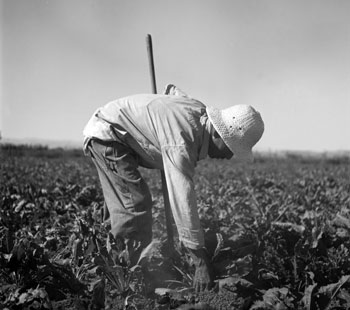
Russell Lee/Library of Congress
These divisions in the camp were reflected in my family. Several years into our incarceration, my father decided that he would apply for repatriation. He had had enough of the mistreatment, feeling that prospects would be better in Japan, where the family had some property. I was astounded and angry. America was my home, and I knew that I was not Japanese. I had no interest in going to Japan. I’d seen enough of the patriarchal, authoritarian style of Japanese society in my own family and others to know that I didn’t want to be a Japanese woman, subservient and under the control of men.
I fought with my parents, even writing letters to magazine editors, but nothing I did would change their minds. As the war wound down I watched as friends left, moving to eastern parts of the U.S. and then back to the West Coast. I was feeling trapped. But when Japan was defeated, my father learned that there was nothing to go back to. He changed his mind and we resettled in Oceanside.
For the rest of my father’s life, we never talked about the camp experience in a serious way. It was too painful. He started farming again but wasn’t very successful. Two years later my mother died of bleeding ulcers. My father became more passive and quiet.
For my part, I was relieved that the ordeal was over and determined to put it out of my mind. I went to college, married a white man, raised a family, lived mostly in white society. I protested the Vietnam War and was active in the civil rights movement. And in the course of these activities, I began to think about my own background.
The wars against Korea and Vietnam made me very aware of American attitudes toward Asians, and the topic of camp came up from time to time. I ran into a therapist at a party who questioned me about my experience, and I brushed it off as not very important. But she pressed on, telling me how formative those early adolescent years were, that I should reexamine those times. This stuck with me, and when a movement for redress began to take shape, I joined in and worked at the legislative level and as a named plaintiff in a court case that went to the Supreme Court.
I learned that the most damaging event that occurred in the camps was a so-called “loyalty questionnaire” administered in 1943, mandatory for everyone 17 and older. It was used to separate the “loyal” from the “disloyal.” It was a poorly designed instrument, resulting in divided families, friends. On the question of agreeing to serve in the American military, to say no was to automatically designate “disloyalty.” My cousins said no and were charged with being draft dodgers. A sympathetic judge fined them one penny.
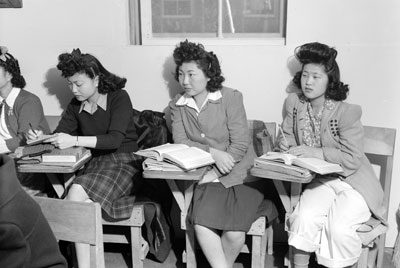
After the government turned the camp at Tule Lake into a segregation center for all “disloyals” and troublemakers, I watched friends loaded onto trucks to be taken there. By the flimsy logic of the day, our family should have been sent there as well — I never learned why we were not. Perhaps a fortunate oversight kept us out.
The government seemed hell-bent on tarnishing all of us as aliens — and enemy aliens at that. How could we remain “loyal” to a country that had held us captive for years, impoverishing us in so many ways? How were we to
respond to these humiliations and victimization? We were expected to disallow our Japanese heritage and submit to the demands of our captors. And we did. But it left us with a badly damaged community, an ever-present split between the “loyals” and “disloyals,” and a deep understanding about how vulnerable we were.
Ironically, we were very good at adapting and melting into the American middle class, earning the label of “model minority.” In my own case, I lost my primal language, distanced myself from the American-Japanese community, and for many years didn’t look back. We paid a heavy emotional price, and the issue of identity has always dogged us: Can we truly be American?
It’s been a long time since World War II, and one would think that Poston would be a fading memory, but it is not. I have made pilgrimages to Tule Lake, seeking a better understanding of our history. Though I have spent my years in white society and my children are half white, I am certain that given particular circumstances, I could be targeted again for my political views, ethnic background, for my religion or being a member of a group identified as other.
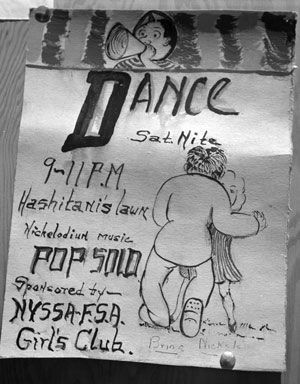
I am not bitter, but I remain quite angry. I am a liberal, a believer in equality, but I am also a cynic. I don’t think that our Founding Fathers really meant to extend equality to everybody, but the words and sentiments remain part of our Constitution. The struggle for our ideals continues, and it is necessary to remind us about what happened to me and 120,000 other Americans, because without that memory, it could easily happen again.
Chizu Omori is a freelance journalist and co-producer of the documentary Rabbit in the Moon with her sister Emiko Omori, chronicling the experiences of Japanese Americans in WWII internment camps. This essay is part of What It Means to Be American, a partnership of the Smithsonian’s National Museum of American History and Zócalo Public Square.
This article is featured in the May/June 2017 issue of The Saturday Evening Post. Subscribe to the magazine for more art, inspiring stories, fiction, humor, and features from our archives.
Originally published at Zócalo Public Square (zocalopublicsquare.org).
The Suspect Americans: A Prelude to Japanese Internment During World War II
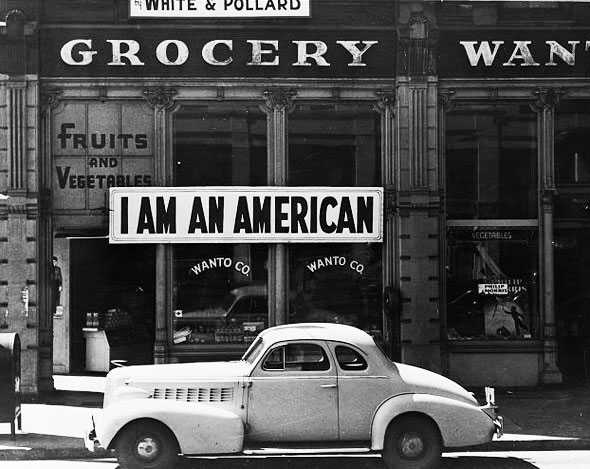
“If we ever have war with Japan,” Lail Kane told the Japanese American Citizens League, “and I have anything to say about it, the first thing I’ll do will be intern every one of you.”
At the time Kane’s comment appeared in a 1939 Post article by Magner White, it must have sounded ridiculous to many Americans. But Lail Kane, a World War I veteran and a prominent white citizen of San Francisco, spoke for many Americans who hated and feared the Japanese Americans living on the West Coast.
White learned of Kane’s comment when he interviewed Togo Tanaka, editor at the Rafu Shimpo, a Japanese-American newspaper in Los Angeles. When asked about white citizens’ resentment of Japanese Americans, Tanaka acknowledged anti-Asian racism was a serious problem. Yet he was confident white Americans would eventually accept Japanese Americans as equals. Until that time, he and other children of Japanese immigrants would work to win their approval.
For people like Lail Kane, though, there seemed to be nothing that could reduce their fear and suspicion. He was convinced Japanese Americans were spying for the Imperial Japanese government. The only solution, when war came, was to put every Japanese American in an internment camp, deep in the desert, for as long as necessary.
You get the sense reading the article that Tanaka simply couldn’t believe Kane’s comment. The idea! Imagine sticking American citizens into internment camps, without trial or right of appeal!
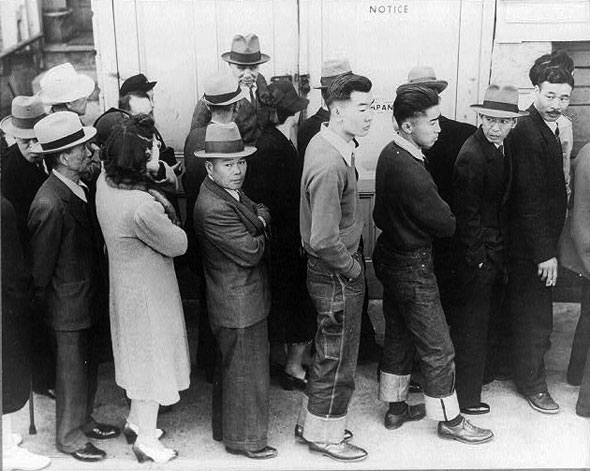
I can’t find much information about Lail Kane, but it appears he had some influence with the government. Either that or he happened to share the racist opinions of some powerful people on the West Coast. Because when war came, the government gathered up over 100,000 Japanese Americans and shipped them to camps in remote areas of Western states. Of this number, 80,000 were first- or second-generation Japanese Americans — U.S. citizens. Their parents, born in Japan, were not; American laws made them ineligible for citizenship.
What made Kane’s comment so shameful was that first-generation Japanese Americans were doing all they could to prove their loyalty to their country. The leader of the Japanese American Citizens League told White, “We are doing our best to educate ourselves for better American citizenship, and then in turn to present ourselves to the American public. No matter what handicaps we have to face, our place is primarily here in the United States and we must prove to America that we are good citizens. We shall simply bide our time and live down the things being said against us.”
Anti-Asian racism had a long history on the West Coast. Many white American settlers, themselves newly arrived in California, resented Asian immigrants, many of whom had come to build America’s railroads. The Japanese, and Chinese, were shunned by many American communities and so kept to themselves. The resentment grew, particularly when some white Americans saw Japanese immigrants’ businesses and farms thriving.
Hatred of the Japanese and their American-born children became mingled with fear in the 1930s, when white Americans worried that Japanese, and their foreign-born parents, were working for the Imperial Japanese government. Learning of the atrocities Japan was inflicting on China, many of these Americans looked accusingly at them.
“When the newsreels were showing the Shanghai bombings,” White wrote, “movie audiences in Los Angeles often showed their feelings. One evening, Fumiye Ruth Tanaka, a svelte, typical compact-carrying, fashionably dressed girl, was in one of these audiences. There flashed a bombing scene.” The scene, known today as Bloody Saturday, showed a baby crying near a railroad track amidst the ruins of Shanghai’s South Railway Station, the lone survivor in a scene of death. The movie crowd began to hiss and boo. A woman next to Tanaka turned on her, noted her features, and demanded, “Are you Japanese or Chinese?”
“Pardon me,” Tanaka said politely, “I’m neither! I’m an American!”
Tanaka was correct. But her innocence, and citizenship, wouldn’t have helped when, three years later, she was forced to leave her home and most of her possessions for a small room in wooden barracks in the middle of the desert.
There was surprisingly little outcry at the internment of Japanese Americans. In the wake of Japan’s attack on Pearl Harbor, most Americans were too enraged to consider seemingly fine points of law, which fortunately didn’t apply to them. Stalwart defenders of civil liberties, like Eleanor Roosevelt, said nothing. The American Civil Liberties Union, which normally would have taken up such a case, chose to remain mute on the matter of internment.
At some level, though, Americans must have recognized the inconsistency of defending freedom while suspending it for their own people. Even Lail Kane, who wanted all Japanese treated as hostile aliens, told White, “In case of war, I wouldn’t hesitate to intern them. On the other hand, we mustn’t forget that they are American citizens and have just as much right to be here as you and I.”
As for Togo Tanaka, despite his efforts to prove his loyalty, he was arrested the day after Pearl Harbor and held in jail for 11 days without any charge. He was released, but soon gathered up with the rest of the Japanese Americans and sent to Camp Manzanar in April 1942. His efforts to cooperate with the government authorities during his confinement won him the enmity of other detainees, and he was eventually relocated to another camp to escape reprisals from other detainees. Released in 1943, he moved to Chicago. He passed away in 2009, a successful businessman who finally gained the respect for which he had long worked.
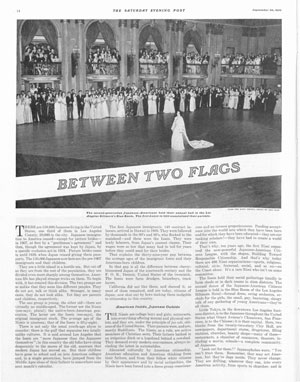
Step into 1939 with a peek at these pages from The Saturday Evening Post 75 years ago: